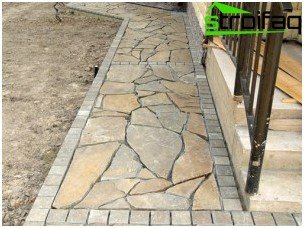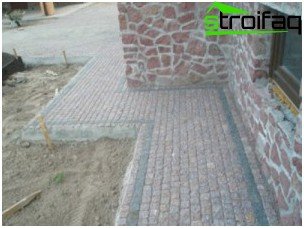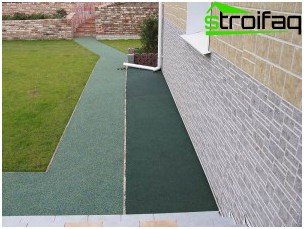When the construction is almost completed and it seems that the house is ready to move in, the accumulated fatigue forces us to turn a blind eye to the little things that still require attention. It was at this time that there was a high probability that small “deficiencies” would be put aside in the “long box”. One of such trifles may turn out to be the blind area around the house. What will happen if you postpone it for several years? And is it necessary to blind area immediately after facing the house?
Content
- Why do you need a blind area around the house
- How to blind around the house yourself
- Classical blind area
- Soft blind area – backfill of gravel
Why do you need a blind area around the house

The blind area trimmed with wild stone
In addition to the purely aesthetic function, the blind area of the house has a very definite practical meaning. The fact is that it protects the foundation from the penetration of sedimentary moisture and uneven washing. It is especially dangerous to leave the building without a blind area for the winter.
Saturated with moisture, the soil freezes and expands, and, therefore, presses on the foundation, which can lead to its destruction. If the soil on your site is heaving, then the blind area must also be insulated.
How to blind around the house yourself
For the construction of the blind areas, it is not necessary to hire specialists, this can be done independently. To start, just remember a few rules:
- For high-quality water drainage, the width of the blind area should be at least 30 cm greater than the width of the eaves of the roof.
- As a rule, the blind area is used as a path around the house and for ease of operation, its width should be at least 1 m. Agree, it’s not very pleasant to rub your shoulder against the walls when walking.
- The angle of the blind area should be 3-10 degrees.
So that as a result you get an excellent blind area around the house with your own hands, consider all options for its organization and select the optimal one for your site.
Classical blind area

Classic blind area around the house
- Along the entire perimeter of the foundation, it is necessary to mark the future blind area. To do this, at the corners (both external and internal) from the wall, measure the necessary distance (the width of the blind area) and drive in the pegs. Between the pegs we stretch a thick thread or rope.
- In the marked area, remove the topsoil to a depth of 0.25 m. It is advisable to remove the removed soil immediately, it will interfere with the work. If your site does not have holes to fill, the soil should be removed.
- On the edge of the trench, we install and fix the removable formwork.
- At the bottom of the trench you need to lay a layer of sand 10 cm thick, and then pour it abundantly with water for shrinkage
- Next is a layer of crushed stone, 5-8 cm thick.
- To strengthen the blind area, it is advisable to use a reinforcing metal mesh. It should be laid on crushed stone and fixed. When calculating the required number of reinforcing mesh, do not forget to take into account that the edges of the sheets overlap each other by 10-15 cm.
- To prevent the blind area from cracking the first winter, it is advisable to make it blocky. To do this, every 1-1.5 meters, install wooden planks with a thickness of 10-15 mm on the edge so that their upper edge coincides with the surface of the future blind area. Before installation, the wood must be soaked with any water-repellent composition. After pouring concrete, the wooden planks will serve as beacons for you to level the blind area. So, in order to facilitate further work, immediately install them at the required angle.
- Now you need to pour cement mortar into the formwork. You can order ready-made concrete at a specialized enterprise, but then you need a large capacity for its temporary storage. In addition, it is almost impossible to cope with the process of transporting concrete from the tank to the blind area alone before it begins to solidify. This will require 4-6 people. Self-preparation of the solution will certainly take longer, but it will allow you to work slowly and save a little.
- When the formwork is filled with mortar, we take the rule and smooth the surface.
- And finally, the last stage. When the solution dries a little, the surface needs to be “ironed”. To do this, sprinkle it with dry cement, which is then rubbed lightly.
It remains only to wait for the solution to dry and the blind area with your own hands is ready.

The blind area paved with clinker
Soft blind area – backfill of gravel
The only drawback of the classic blind area is the fact that it must be regularly repaired.
Under the influence of precipitation and low temperatures, concrete cracks. If you are seriously thinking about how to make the blind area around the house more durable, use the following technology:
- At the bottom of the prepared trench, a depth of 25-30 cm, lay a layer of clay (about 10 cm).
- The next layer is waterproofing material – hydroisol or euroroofing material. It must be pressed to the foundation using a bar at a height of 12-15 cm from the clay level.
Important! The sheet of insulating material must not be stretched. Better let it form folds. Otherwise, in the process of temperature fluctuations of the soil, it may break..
- Ruberoid is covered with sand (5 cm).
- Fill the remaining space with rubble.
In principle, the soft blind area of the house is ready, but it can only be used when drainage is organized on the roof of the house. Otherwise, jets of water will regularly wash unattractive grooves in the rubble. If you care about aesthetics and convenience, then the layer of rubble can be made a little thinner, cover it with sand and lay light paving slabs.
Important! All layers, starting with waterproofing, should be located at an angle of 5-7 degrees.

One of the options for independent decoration of the blind area is backfilling with gravel
Thermal insulation blind areas
In areas with heaving soil, the blind area of any type must be insulated. To do this, it is advisable to use a moisture-proof heat-insulating material – extruded polystyrene foam is placed under a decorative coating or concrete.
Important! Expanded polystyrene does not withstand point loads, therefore it cannot be used under gravel or crushed stone.
So, now you know how to blind yourself at home. And choose the type of coating and the degree of thermal insulation yourself, in accordance with the characteristics of the soil on your site. If you manage to choose the coating material so that it is in harmony with the decoration of the facade and the adjacent area, the blind area will not only preserve the integrity of your home for many years, but will also become a real decoration of the site.


